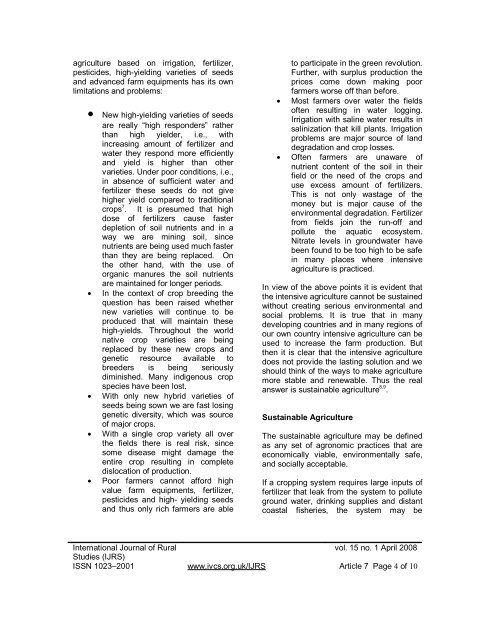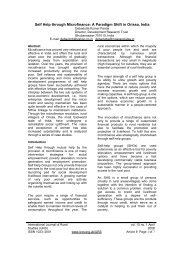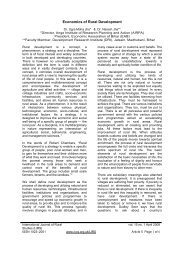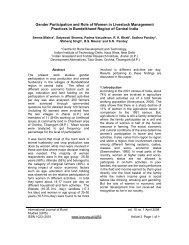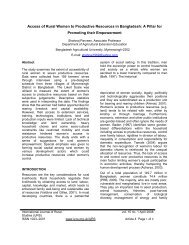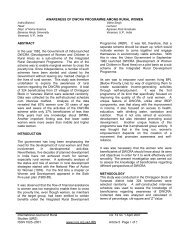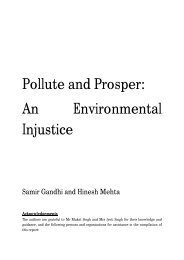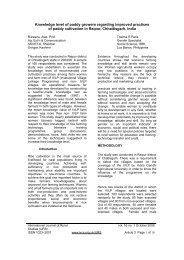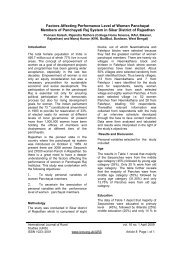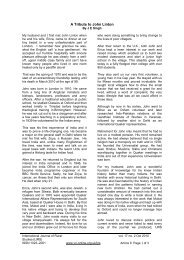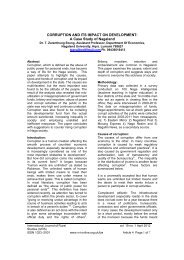7. Agriculture in India: Land use and sustainability - Volunteers for ...
7. Agriculture in India: Land use and sustainability - Volunteers for ...
7. Agriculture in India: Land use and sustainability - Volunteers for ...
Create successful ePaper yourself
Turn your PDF publications into a flip-book with our unique Google optimized e-Paper software.
agriculture based on irrigation, fertilizer,<br />
pesticides, high-yield<strong>in</strong>g varieties of seeds<br />
<strong>and</strong> advanced farm equipments has its own<br />
limitations <strong>and</strong> problems:<br />
• New high-yield<strong>in</strong>g varieties of seeds<br />
are really “high responders” rather<br />
than high yielder, i.e., with<br />
<strong>in</strong>creas<strong>in</strong>g amount of fertilizer <strong>and</strong><br />
water they respond more efficiently<br />
<strong>and</strong> yield is higher than other<br />
varieties. Under poor conditions, i.e.,<br />
<strong>in</strong> absence of sufficient water <strong>and</strong><br />
fertilizer these seeds do not give<br />
higher yield compared to traditional<br />
crops 7 . It is presumed that high<br />
dose of fertilizers ca<strong>use</strong> faster<br />
depletion of soil nutrients <strong>and</strong> <strong>in</strong> a<br />
way we are m<strong>in</strong><strong>in</strong>g soil, s<strong>in</strong>ce<br />
nutrients are be<strong>in</strong>g <strong>use</strong>d much faster<br />
than they are be<strong>in</strong>g replaced. On<br />
the other h<strong>and</strong>, with the <strong>use</strong> of<br />
organic manures the soil nutrients<br />
are ma<strong>in</strong>ta<strong>in</strong>ed <strong>for</strong> longer periods.<br />
• In the context of crop breed<strong>in</strong>g the<br />
question has been raised whether<br />
new varieties will cont<strong>in</strong>ue to be<br />
produced that will ma<strong>in</strong>ta<strong>in</strong> these<br />
high-yields. Throughout the world<br />
native crop varieties are be<strong>in</strong>g<br />
replaced by these new crops <strong>and</strong><br />
genetic resource available to<br />
breeders is be<strong>in</strong>g seriously<br />
dim<strong>in</strong>ished. Many <strong>in</strong>digenous crop<br />
species have been lost.<br />
• With only new hybrid varieties of<br />
seeds be<strong>in</strong>g sown we are fast los<strong>in</strong>g<br />
genetic diversity, which was source<br />
of major crops.<br />
• With a s<strong>in</strong>gle crop variety all over<br />
the fields there is real risk, s<strong>in</strong>ce<br />
some disease might damage the<br />
entire crop result<strong>in</strong>g <strong>in</strong> complete<br />
dislocation of production.<br />
• Poor farmers cannot af<strong>for</strong>d high<br />
value farm equipments, fertilizer,<br />
pesticides <strong>and</strong> high- yield<strong>in</strong>g seeds<br />
<strong>and</strong> thus only rich farmers are able<br />
to participate <strong>in</strong> the green revolution.<br />
Further, with surplus production the<br />
prices come down mak<strong>in</strong>g poor<br />
farmers worse off than be<strong>for</strong>e.<br />
• Most farmers over water the fields<br />
often result<strong>in</strong>g <strong>in</strong> water logg<strong>in</strong>g.<br />
Irrigation with sal<strong>in</strong>e water results <strong>in</strong><br />
sal<strong>in</strong>ization that kill plants. Irrigation<br />
problems are major source of l<strong>and</strong><br />
degradation <strong>and</strong> crop losses.<br />
• Often farmers are unaware of<br />
nutrient content of the soil <strong>in</strong> their<br />
field or the need of the crops <strong>and</strong><br />
<strong>use</strong> excess amount of fertilizers.<br />
This is not only wastage of the<br />
money but is major ca<strong>use</strong> of the<br />
environmental degradation. Fertilizer<br />
from fields jo<strong>in</strong> the run-off <strong>and</strong><br />
pollute the aquatic ecosystem.<br />
Nitrate levels <strong>in</strong> groundwater have<br />
been found to be too high to be safe<br />
<strong>in</strong> many places where <strong>in</strong>tensive<br />
agriculture is practiced.<br />
In view of the above po<strong>in</strong>ts it is evident that<br />
the <strong>in</strong>tensive agriculture cannot be susta<strong>in</strong>ed<br />
without creat<strong>in</strong>g serious environmental <strong>and</strong><br />
social problems. It is true that <strong>in</strong> many<br />
develop<strong>in</strong>g countries <strong>and</strong> <strong>in</strong> many regions of<br />
our own country <strong>in</strong>tensive agriculture can be<br />
<strong>use</strong>d to <strong>in</strong>crease the farm production. But<br />
then it is clear that the <strong>in</strong>tensive agriculture<br />
does not provide the last<strong>in</strong>g solution <strong>and</strong> we<br />
should th<strong>in</strong>k of the ways to make agriculture<br />
more stable <strong>and</strong> renewable. Thus the real<br />
answer is susta<strong>in</strong>able agriculture 8,9 .<br />
Susta<strong>in</strong>able <strong>Agriculture</strong><br />
The susta<strong>in</strong>able agriculture may be def<strong>in</strong>ed<br />
as any set of agronomic practices that are<br />
economically viable, environmentally safe,<br />
<strong>and</strong> socially acceptable.<br />
If a cropp<strong>in</strong>g system requires large <strong>in</strong>puts of<br />
fertilizer that leak from the system to pollute<br />
ground water, dr<strong>in</strong>k<strong>in</strong>g supplies <strong>and</strong> distant<br />
coastal fisheries, the system may be<br />
International Journal of Rural<br />
vol. 15 no. 1 April 2008<br />
Studies (IJRS)<br />
ISSN 1023–2001 www.ivcs.org.uk/IJRS Article 7 Page 4 of 10


